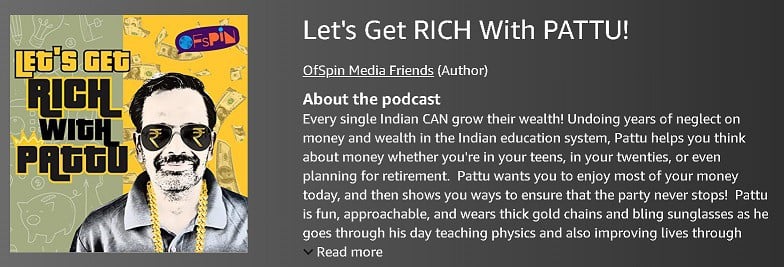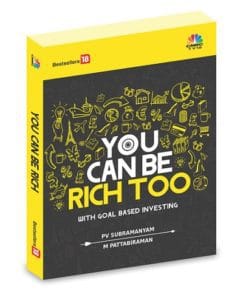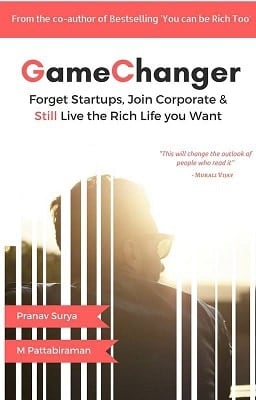Last Updated on September 22, 2016 at 10:53 am
The idea of a risk premium is one of the most important investing concepts essential for those who invest in volatile assets and those who shun them as too ‘risky’.
The definition of a risk premium is fairly simple. If a risk-free instrument offers say 7% return, what is the return I should expect for the risk I wish to take? Or in other words, what is the return I expect? If this is 10%, then risk premium is simply 10% – 7% = 3%. In other words, the risk premium is the expected compensation for the risk taken.
Very few investors realise that the risk premium is also the money lost when an investor decides to invest in a risk-free asset. For example, when we invest in a bank FD at 6-8%, what does the bank gain from it? It lends the money at a much higher rate to corporates.
Did you know that the central government does the same with our PPF and SSY and other small saving schemes money? It lends it to our states at a ‘premium’ of about 2%. Did you think these schemes are EEE for our benefit!!
Join over 32,000 readers and get free money management solutions delivered to your inbox! Subscribe to get posts via email! 🔥Enjoy massive discounts on our robo-advisory tool & courses! 🔥
Take LIC (or any other insurer). It invests a part of the money obtained via traditional policies and invests it in the stock market. Part of the bonus given to policyholders is from capital gains obtained by booking profits from time to time.
The point I wish to make is, when we choose to avoid risk, someone else will profit from it. This is the premium we pay.
In other words, risk premium cuts both ways. If we choose to take a risk, we may be adequately compensated. If we choose not to take a risk, we have to pay compensation. There is no free lunch.
By directly investing in stocks, bonds, gold or any product that is valued at market price each business day, we are eliminating the middlemen – banks, insurers, the government etc. This gives a shot at earning more.
Now, assuming that we do choose to invest in volatile instruments directly, it is important to recognise that the volatility does not reduce with time. Equity mutual funds are commonly mis-sold and mis-bought by saying that returns will be “good” over the long term. The implication of that statement is risk will reduce if we stay invested through thick and thin. This is absolute rubbish.
Want proof? Read more:
Understanding the Nature of Stock Market Returns
Will long-term equity investing always be successful?
Dollar Cost Averaging aka SIP analysis of S&P 500 and BSE Sensex
Take the case of those suggest investing “more” in small cap, micro cap and nano cap mutual funds. The assumption here is that the volatility does not matter over the long term. Again a baseless assumption.
By assuming risk will reduce to such an extent that there would be no capital loss over the long term, we are assuming that the return from equity would be practically risk-free. Such a notion is extremely dangerous.
What is risk?!
A positive risk premium means little. If I get a return of 9% over a risk-free rate of 7%, the risk premium is 2%, but real life inflation is often much higher than 9%. So there is not much to rejoice.
The traditional definition of a risk premium is of limited use in countries where actual inflation is in double digits. The change in cost inflation index or wholesale price index is of little relevance to how we run our lives.
Measuring risk premium
If I know the risk-free return and the expected return, it is trivial to calculate the risk premium. However, risk premium per se does not make any sense without the actual return obtained.
A risk-free return is usually a fixed income asset which offers interest on the amount invested and then interest for the interest and amount. That is the classic definition of compounding applies. The interest offered each year is the same (say 7%).
So after say 5 years, Rs. 100 invested becomes
100 x (1+7%) x x (1+7%) x (1+7%) x (1+7%) x (1+7%)
or 100 x (1+7%) ^5 – the classic compound interest formula.
However, a market linked instrument does not interest and one cannot apply the above formula straight away.
Instead one calculates growth (or lack thereof) each year.
For example, Rs. 100 invested became Rs. 140 in one year and that amount reduced to Rs. 120 after one more year and so on.
Or in other words, 40% growth = return in the first year, -14.3% return in the second year and so on.
Therefore, I can write,
100 x (1+40%) x(1-14.3%) x (1+10%) x (1+19%) x (1-6%) = 147.63
Now this is messy. I can replace the above equation by
100 x (1+ R) = 147.63
This R is the average growth in our investment year upon year and is known as the compounded annualised average return (CAGR). That is we are replacing the volatile annual rates of growth by a single rate of growth.
Had our investment grown at the same rate of growth year after year for 5 years, Rs. 100 would have become Rs. 147.63 with R = CAGR = 8.10%.
Many people make the mistake of assuming that 8.10% is the actual yearly growth rate. It is not. Each year’s growth rate has fluctuated violently as shown above.
The key takeaway is, we need to replace the various growth rates by a single growth rate to enable comparison with the risk-free rate. Without the CAGR, we will never know if our investment has beat a risk free investment or not. The risk premium will not have any meaning.
Read more: Understanding Annualized Return: CAGR and XIRR
🔥Enjoy massive discounts on our courses, robo-advisory tool and exclusive investor circle! 🔥& join our community of 5000+ users!
Use our Robo-advisory Tool for a start-to-finish financial plan! ⇐ More than 1,000 investors and advisors use this!
New Tool! => Track your mutual funds and stock investments with this Google Sheet!
We also publish monthly equity mutual funds, debt and hybrid mutual funds, index funds and ETF screeners and momentum, low-volatility stock screeners.





- Do you have a comment about the above article? Reach out to us on Twitter: @freefincal or @pattufreefincal
- Have a question? Subscribe to our newsletter using the form below.
- Hit 'reply' to any email from us! We do not offer personalized investment advice. We can write a detailed article without mentioning your name if you have a generic question.
Join over 32,000 readers and get free money management solutions delivered to your inbox! Subscribe to get posts via email!
About The Author
 Dr M. Pattabiraman(PhD) is the founder, managing editor and primary author of freefincal. He is an associate professor at the Indian Institute of Technology, Madras. He has over ten years of experience publishing news analysis, research and financial product development. Connect with him via Twitter(X), Linkedin, or YouTube. Pattabiraman has co-authored three print books: (1) You can be rich too with goal-based investing (CNBC TV18) for DIY investors. (2) Gamechanger for young earners. (3) Chinchu Gets a Superpower! for kids. He has also written seven other free e-books on various money management topics. He is a patron and co-founder of “Fee-only India,” an organisation promoting unbiased, commission-free investment advice.
Dr M. Pattabiraman(PhD) is the founder, managing editor and primary author of freefincal. He is an associate professor at the Indian Institute of Technology, Madras. He has over ten years of experience publishing news analysis, research and financial product development. Connect with him via Twitter(X), Linkedin, or YouTube. Pattabiraman has co-authored three print books: (1) You can be rich too with goal-based investing (CNBC TV18) for DIY investors. (2) Gamechanger for young earners. (3) Chinchu Gets a Superpower! for kids. He has also written seven other free e-books on various money management topics. He is a patron and co-founder of “Fee-only India,” an organisation promoting unbiased, commission-free investment advice.Our flagship course! Learn to manage your portfolio like a pro to achieve your goals regardless of market conditions! ⇐ More than 3,000 investors and advisors are part of our exclusive community! Get clarity on how to plan for your goals and achieve the necessary corpus no matter the market condition is!! Watch the first lecture for free! One-time payment! No recurring fees! Life-long access to videos! Reduce fear, uncertainty and doubt while investing! Learn how to plan for your goals before and after retirement with confidence.
Our new course! Increase your income by getting people to pay for your skills! ⇐ More than 700 salaried employees, entrepreneurs and financial advisors are part of our exclusive community! Learn how to get people to pay for your skills! Whether you are a professional or small business owner who wants more clients via online visibility or a salaried person wanting a side income or passive income, we will show you how to achieve this by showcasing your skills and building a community that trusts and pays you! (watch 1st lecture for free). One-time payment! No recurring fees! Life-long access to videos!
Our new book for kids: “Chinchu Gets a Superpower!” is now available!


Must-read book even for adults! This is something that every parent should teach their kids right from their young age. The importance of money management and decision making based on their wants and needs. Very nicely written in simple terms. - Arun.Buy the book: Chinchu gets a superpower for your child!
How to profit from content writing: Our new ebook is for those interested in getting side income via content writing. It is available at a 50% discount for Rs. 500 only!
Do you want to check if the market is overvalued or undervalued? Use our market valuation tool (it will work with any index!), or get the Tactical Buy/Sell timing tool!
We publish monthly mutual fund screeners and momentum, low-volatility stock screeners.
About freefincal & its content policy. Freefincal is a News Media Organization dedicated to providing original analysis, reports, reviews and insights on mutual funds, stocks, investing, retirement and personal finance developments. We do so without conflict of interest and bias. Follow us on Google News. Freefincal serves more than three million readers a year (5 million page views) with articles based only on factual information and detailed analysis by its authors. All statements made will be verified with credible and knowledgeable sources before publication. Freefincal does not publish paid articles, promotions, PR, satire or opinions without data. All opinions will be inferences backed by verifiable, reproducible evidence/data. Contact information: letters {at} freefincal {dot} com (sponsored posts or paid collaborations will not be entertained)
Connect with us on social media
- Twitter @freefincal
- Subscribe to our YouTube Videos
- Posts feed via Feedburner.
Our publications
You Can Be Rich Too with Goal-Based Investing
 Published by CNBC TV18, this book is meant to help you ask the right questions and seek the correct answers, and since it comes with nine online calculators, you can also create custom solutions for your lifestyle! Get it now.
Published by CNBC TV18, this book is meant to help you ask the right questions and seek the correct answers, and since it comes with nine online calculators, you can also create custom solutions for your lifestyle! Get it now.Gamechanger: Forget Startups, Join Corporate & Still Live the Rich Life You Want
 This book is meant for young earners to get their basics right from day one! It will also help you travel to exotic places at a low cost! Get it or gift it to a young earner.
This book is meant for young earners to get their basics right from day one! It will also help you travel to exotic places at a low cost! Get it or gift it to a young earner.Your Ultimate Guide to Travel
 This is an in-depth dive into vacation planning, finding cheap flights, budget accommodation, what to do when travelling, and how travelling slowly is better financially and psychologically, with links to the web pages and hand-holding at every step. Get the pdf for Rs 300 (instant download)
This is an in-depth dive into vacation planning, finding cheap flights, budget accommodation, what to do when travelling, and how travelling slowly is better financially and psychologically, with links to the web pages and hand-holding at every step. Get the pdf for Rs 300 (instant download)